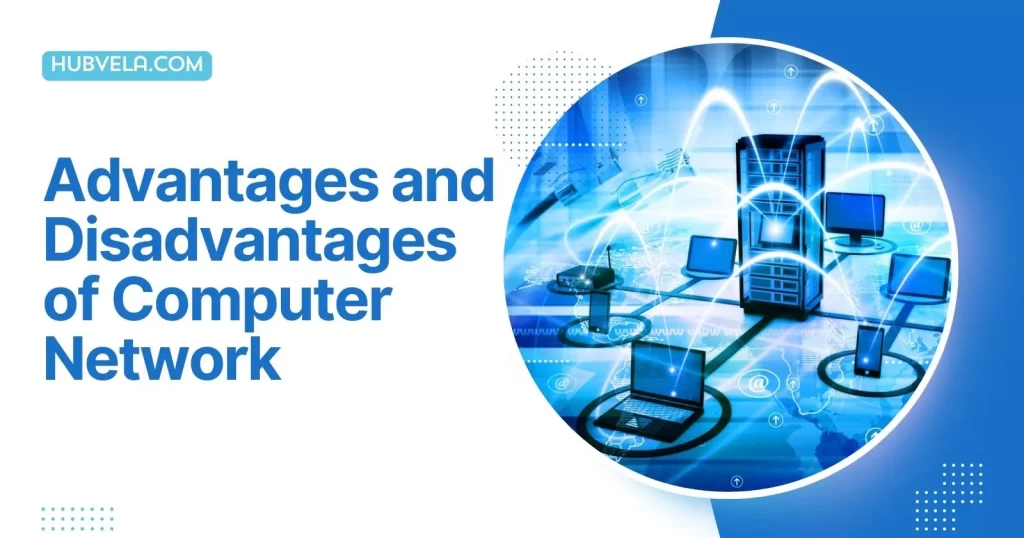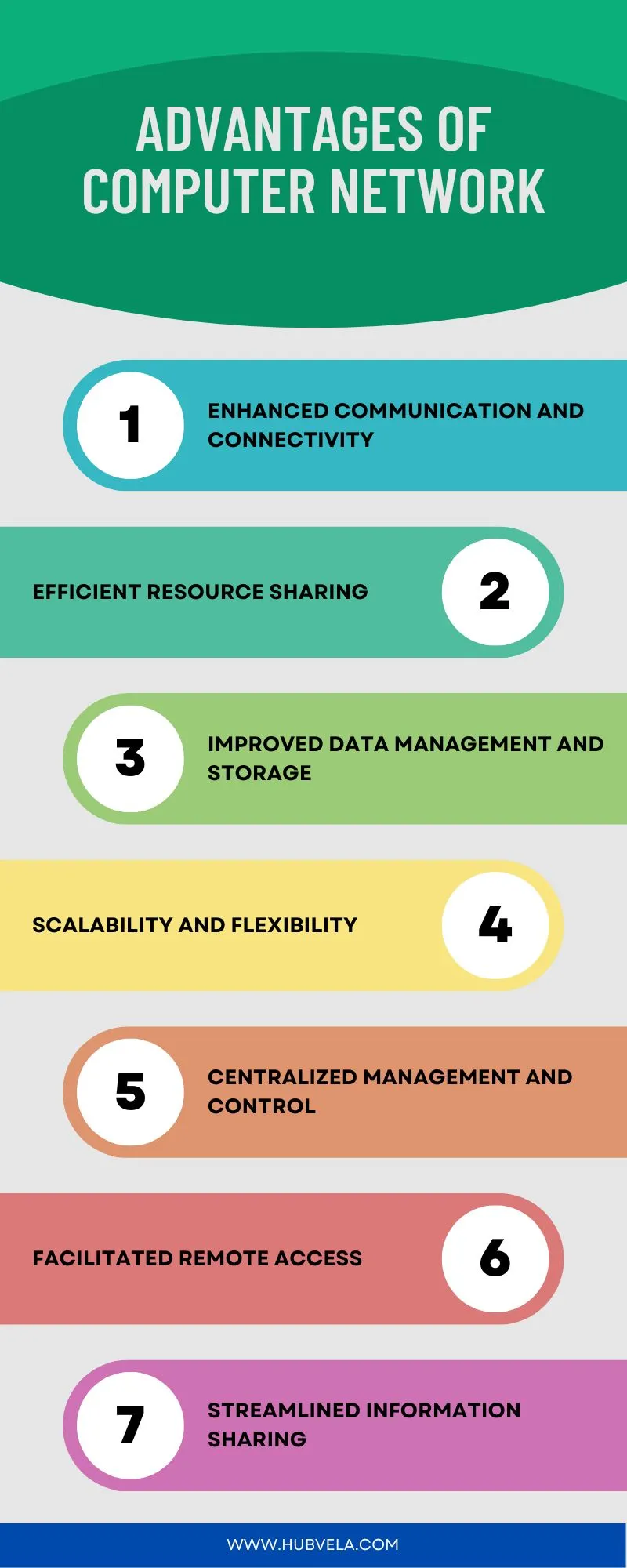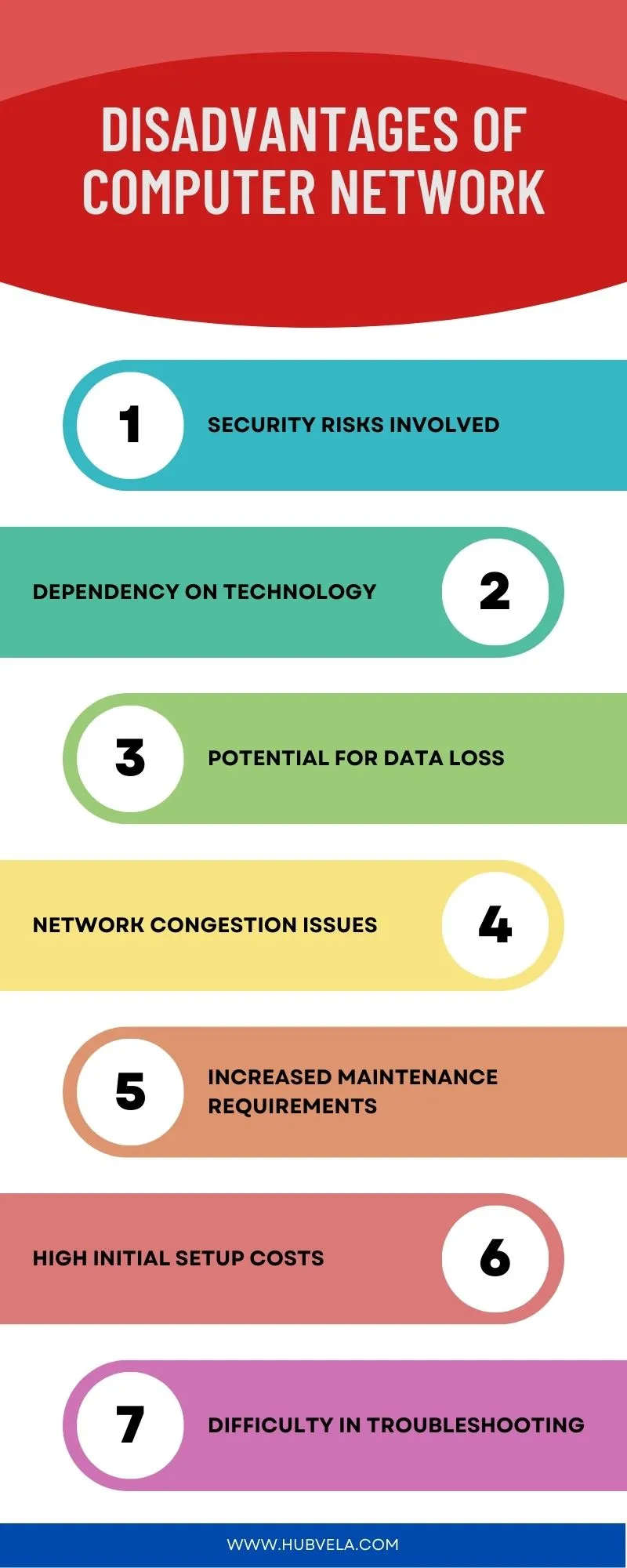While computer networks bring enhanced communication and connectivity, efficient resource sharing, and improved data management, they also come with their fair share of drawbacks.
On the positive side, computer networks allow you to communicate and connect with others seamlessly. You can share resources efficiently and manage your data more effectively. Additionally, networks offer scalability and flexibility to adapt to changing needs.
However, it’s important to note that maintaining a network can be time-consuming and costly, with high initial setup expenses. Troubleshooting network issues can also be challenging.
In this article, we will explore the advantages and disadvantages of computer networks, helping you understand the potential benefits and downsides.

--Advertisement--
Advantages of Computer Network
Computer networking offers various advantages, making it an essential aspect of modern business and communication. Some of the key benefits of computer networking include:

1. Enhanced Communication and Connectivity
With a computer network, you can experience enhanced communication and connectivity by easily sharing information and collaborating with others.
One of the advantages of computer networks is improved communication efficiency. By connecting multiple devices and users, information can be shared quickly and easily, allowing for seamless communication within an organization.
Additionally, computer networks enable remote collaboration, allowing individuals to work together from different locations. This real-time connectivity allows for faster decision-making and problem-solving.
Another benefit is the improved productivity that comes with enhanced communication and connectivity. Teams can work together more efficiently, sharing resources and information instantly.
Lastly, computer networks contribute to enhanced customer service. With improved communication channels, businesses can respond to customer inquiries and provide support more effectively, leading to higher customer satisfaction.
2. Efficient Resource Sharing
Maximize your efficiency by leveraging the power of efficient resource sharing in a computer network.
One of the advantages of a computer network is that it allows for efficient resource allocation. By connecting multiple devices and users, a network enables the sharing of resources such as files, software, and hardware. This means that instead of each individual having their own set of resources, they can access and utilize shared resources, leading to improved collaboration and increased productivity.
Furthermore, efficient resource sharing can result in cost savings, as it eliminates the need for redundant resources. With better access to shared resources, decision-making becomes more informed and effective.
3. Improved Data Management and Storage
Leverage the advantages of a computer network to efficiently manage and store data.
One of the key benefits is improved data security. With a computer network, you can implement robust security measures such as firewalls, encryption, and access controls to protect your data from unauthorized access or loss.
Additionally, a computer network allows for increased data accessibility. Users can access and retrieve data from anywhere, anytime, as long as they’ve the necessary permissions and network connectivity.
Moreover, efficient backup and recovery mechanisms are facilitated through the network, ensuring that your data is backed up regularly and can be easily restored in case of any system failures or data loss.
The network also enables seamless collaboration among team members, as they can easily share and edit files in real-time.
Lastly, a computer network reduces hardware costs by centralizing data storage, eliminating the need for individual storage devices for each user.
4. Scalability and Flexibility
You can easily scale and adapt your computer network to meet the changing needs of your organization.
Scalability challenges and growth constraints can be overcome through network expansion.
With a computer network, you have the flexibility to add or remove devices, upgrade hardware or software, and adjust network configurations as needed.
This allows your organization to efficiently accommodate increased data traffic, user demands, and technological advancements.
The adaptability of computer networks also enables you to respond to new business opportunities and challenges.
However, there may be some limitations to flexibility, such as compatibility issues between different network components or adaptability issues with legacy systems.
Nevertheless, the overall scalability and flexibility of computer networks offer significant advantages in terms of meeting the dynamic requirements of your organization.
5. Centralized Management and Control
With a computer network, you can easily manage and control your organization’s resources in a centralized manner. This centralized control allows for efficient network administration and streamlined operations.
By having a centralized management system, you can easily monitor the entire network, ensuring smooth functionality and addressing any issues promptly. Network administrators can access and manage all connected devices and systems from a central location, simplifying the management process.
Additionally, centralized security measures can be implemented to protect the network and its resources from unauthorized access or breaches. This ensures that all data and information within the network are secure and protected.
6. Facilitated Remote Access
Facilitated remote access in a computer network offers convenient connectivity, allowing seamless accessibility to resources from any location. This advantage of computer networks has significantly transformed the way we collaborate, work, learn, support, and monitor remotely.
With remote collaboration, teams can work together on projects regardless of their physical locations, increasing productivity and efficiency. Remote working has become increasingly popular, allowing individuals to work from home or any other location, reducing commuting time and expenses.
Remote learning has also gained momentum, enabling students to access educational resources and participate in virtual classrooms from anywhere in the world. Additionally, remote support enables IT professionals to troubleshoot and resolve technical issues remotely, saving time and resources.
Furthermore, remote monitoring allows businesses to monitor systems, networks, and equipment remotely, ensuring optimal performance and timely maintenance.
7. Streamlined Information Sharing
Streamlined information sharing is a key advantage of computer networks, allowing seamless transfer of data and resources between connected devices.
The benefits of this streamlined information sharing are numerous. Firstly, it enables efficient collaboration among individuals or teams located in different physical locations, promoting productivity and saving time.
Additionally, it allows for real-time access to updated information, ensuring that everyone has access to the most current data. This helps in making informed decisions and avoiding errors caused by outdated information.
Moreover, streamlined information sharing simplifies the process of sharing files and documents, eliminating the need for physical copies and reducing paper waste.
However, there are also some drawbacks and challenges to consider. For instance, security concerns arise when sharing sensitive information over a network, requiring robust security measures to protect against unauthorized access.
Furthermore, technical issues such as network failures or slow connections can hinder the smooth flow of information.
Despite these disadvantages, the advantages of streamlined information sharing make computer networks an invaluable tool in today’s digital age.
Disadvantages of Computer Network
Computer networks are essential tools in today’s digital world, enabling seamless communication and data sharing between devices.
However, despite their numerous advantages, computer networks also have some disadvantages that must be considered. We will discuss the key disadvantages of computer networks, including:

1. Security Risks Involved
One significant disadvantage of computer networks is the potential for numerous security risks. In today’s digital age, security threats such as data breaches, network vulnerabilities, and cyber attacks are becoming increasingly prevalent. These risks pose a significant threat to data privacy and the overall integrity of computer networks.
Data breaches can result in the unauthorized access, theft, or manipulation of sensitive information, leading to severe consequences for individuals and organizations alike. Network vulnerabilities, on the other hand, refer to weaknesses in network infrastructure that can be exploited by attackers.
Cyber attacks encompass a range of malicious activities, including malware infections, phishing attacks, and denial-of-service attacks. These security risks underscore the importance of implementing robust security measures to protect computer networks and safeguard data privacy.
2. Dependency on Technology
To further explore the disadvantages of computer networks, it’s important to address the potential dependency on technology that can arise.
One major drawback of computer networks is the increased reliance on technology. This dependency can have negative impact on productivity if there are any issues with the network. System downtime, whether due to technical glitches or maintenance, can bring operations to a halt and result in significant productivity losses.
Additionally, there are cybersecurity concerns associated with computer networks. As technology advances, so do the threats and vulnerabilities.
This means that organizations must invest in robust cybersecurity measures to protect their networks and data.
Furthermore, computer networks require skilled individuals to set up, monitor, and maintain them. This skill requirement can increase costs for organizations that need to hire or train employees with the necessary expertise.
3. Potential for Data Loss
Data loss is a potential risk that frequently occurs in computer networks. When it comes to data security, computer networks can be vulnerable to various threats. While network reliability is crucial, it isn’t foolproof, and data loss can happen due to hardware failures, software glitches, or even human error.
Without proper backup and recovery systems in place, data loss can have severe consequences for businesses and individuals alike.
A data breach can result in the exposure of sensitive information, leading to financial loss, legal issues, and damage to reputation. Moreover, data integrity can be compromised, affecting the accuracy and reliability of information stored in the network.
Therefore, it’s essential to implement robust security measures and backup procedures to minimize the risk of data loss in computer networks.
4. Network Congestion Issues
When managing a computer network, you should be aware of the potential network congestion issues that can arise.
Network congestion refers to the situation when the network becomes overwhelmed with excessive data traffic, leading to a significant impact on network performance.
There are several causes of network congestion, including high data volume, limited bandwidth, and inefficient network design.
The impact of network congestion can range from increased latency to complete network failure.
To prevent network congestion, you can implement measures such as traffic shaping, load balancing, and prioritizing network traffic.
It’s important to note that network congestion is different from network delay, which refers to the time taken for data to travel from one point to another.
5. Increased Maintenance Requirements
Managing a computer network can be challenging due to the increased maintenance requirements that come with it. One of the main disadvantages of computer networks is the potential for network downtime.
This can occur as a result of hardware failures, such as routers or switches malfunctioning.
Additionally, regular software updates are necessary to ensure the network’s security and performance. These updates can be time-consuming and may require system downtime.
Another maintenance requirement is the need for ongoing training. As technology advances, network administrators must stay up-to-date with the latest developments and acquire new skills. This helps them effectively manage the network and troubleshoot any issues that arise.
6. High Initial Setup Costs
Are you concerned about the high initial setup costs associated with computer networks? While it’s true that implementing a computer network can require a significant financial investment, it’s important to consider the long-term benefits and potential return on investment.
Yes, there may be financial challenges in the beginning, but conducting a thorough cost-effectiveness analysis can help determine if the investment is worthwhile.
Remember, a computer network is a long-term investment that can streamline operations, enhance productivity, and improve communication within your organization.
It can also lead to cost savings in the long run by reducing the need for physical infrastructure and increasing efficiency. Therefore, while the high initial setup costs may seem daunting, the potential benefits make it a worthwhile investment.
7. Difficulty in Troubleshooting
Dealing with troubleshooting difficulties can be a drawback of computer networks. When problems arise, such as network performance issues or network configuration problems, it can be challenging to identify and resolve them.
Troubleshooting challenges can arise due to the complex nature of computer networks and the numerous interconnected components involved.
Network diagnostics can be time-consuming and require technical expertise. Additionally, obtaining reliable technical support may not always be readily available, leading to delays in resolving issues.
The difficulty in troubleshooting can result in prolonged downtime, decreased productivity, and frustration among users.
It’s essential to have skilled IT professionals who can efficiently troubleshoot and resolve network problems to minimize disruptions and ensure optimal network performance.
Conclusion on Advantages and Disadvantages of Computer Network
In conclusion, you can weigh the advantages and disadvantages of a computer network to make an informed decision.
The advantages of a computer network, such as increased efficiency and collaboration, often outweigh the disadvantages. Computer networks have a significant impact on productivity by allowing multiple users to access and share resources simultaneously.
They also have future implications, as they enable organizations to adapt to technological advancements and stay competitive.
However, network reliability can be a concern, as any disruption can lead to downtime and loss of data. User training is crucial to ensure that employees can effectively navigate and utilize the network.


